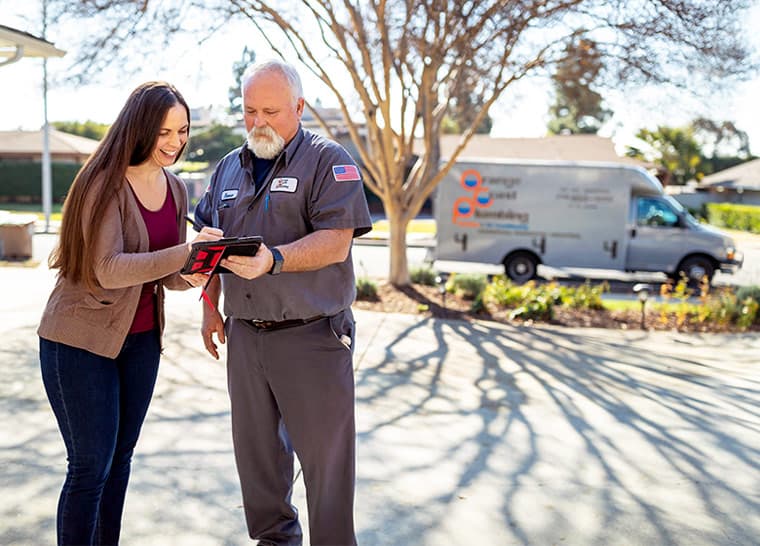So much for beer and football on a Sunday afternoon.
The toilet’s exploding. You’re facing a plumbing emergency.
Anything significant requires a plumber, but what about the smaller emergencies that arise? A clogged toilet? A blocked sink? Even a leaky faucet?
Do you have the right tools for a DIY repair or plumbing Band-Aid until the plumber arrives?
Here’s what you’ll need in your emergency plumbing toolkit.
1. Plungers
There’s a reason why we pluralize the word.
Plungers are the go-to tool for clearing drain clogs.
But you’ll need two plunger types: a cup plunger for sinks and tubs and a flange or accordion plunger for toilets.
Cup plungers are great for sinks but lousy for toilets.
And with flange plungers, it’s just the reverse. Those who’ve tried the one-size-all approach know how frustrating it is to flail about the toilet with a sink plunger that gets no suction in the curved geometry of a toilet trap.
If you anticipate sink and toilet clogs in your home, buy a plunger for each.
2. A Drain Auger
You may have to step up your game for stubborn clogs, which laugh in the face of plungers. A drain auger — also called a drain snake — may do the trick for tough babies.
This coiled metal cable has a spring coil head and a crank handle for manual maneuvering the shaft down the pipes. Then you twist and turn it to break through clogs, even those that have settled far down your plumbing system.
Augers come in various sizes and price points, from basic models to more complex tools with features like automatic feed control. The size you choose depends on the pipes you’re dealing with and the blockages you face.
3. A Toilet Auger
Sorry no, your drain auger won’t work for the toilet any more than your sink plunger.
It’s capable of doing the job, but at a cost. A drain auger will damage the toilet’s porcelain.
A toilet auger is designed and shaped for toilet clogs and comes with a protective sleeve where it touches the toilet bowl.
Buy one. Your tool-envious neighbor will be impressed and may become your BFF when his two-year-old heaves a diaper down the toilet.
4. Tongue-and-Groove Pliers
Also known as channel lock pliers, tongue-and-groove pliers should be a staple of any home tool chest, not just your plumbing toolkit.
They’re meant for gripping, twisting, and tightening pipes and other plumbing fixtures, making them the perfect multi-purpose tool. They have long handles for leverage and adjustable serrated jaws that grip various-sized objects.
They can also crack walnuts if you misplace the nutcracker. A handier tool was never invented.
5. Pipe Wrenches
Pipe wrenches, or “monkey wrenches,” are among the oldest and most useful plumbing tools, essential for any pipe installation or repair.
These study suckers have adjustable jaws that lock onto round surfaces like pipes and fittings.
But wait! We already have channel locks in our emergency plumbing kit!
Pipe wrenches are for bigger and tighter jobs. And you won’t lose your grip, which can happen with pliers.
When shopping, choosed a pipe wrench with hardened-steel serrated jaws and an ergonomic handle grip — you’ll be thankful you did!
Also, consider purchasing at least two different sizes: 10-inch and 6-inch, for starters.
6. A Basin Wrench
A basin wrench is designed for one purpose: to remove and replace the nut underneath a sink or basin.
In some ways, it looks like an oversized pipe wrench with a long handle and thin jaws that fit into tight spaces.
It can reach nuts buried behind faucets and inacessible to other tools, helping you do the job without disassembling stuff thats in the way.
If you’re buying one of these, opt for an adjustable model to adjust its head angle as you work through various positions.
7. Teflon Tape
Teflon tape, also known as thread seal tape, combats leaks in household plumbing. This PTFE tape comes in various widths and lengths. It works with iron, brass, copper, aluminum, stainless steel, and plastic pipes.
Applying Teflon tape is simple — wrap it around the male threads of a pipe before connecting it. No drying time is needed — you can turn on the water immediately.
Teflon tape can seal gas lines and create air-tight seals on vacuum pumps. The high-grade adhesive coating ensures it will stay in place through the harshest weather conditions or temperature changes.
8. A Quality Hacksaw
We hope you hung onto the hacksaw from your prison break — you’ll need it in your emergency plumbing kit.
No other tool replaces it.
A hacksaw will cut through PVC piping, copper, ceramic, and even galvanized steel — materials that would bend, break, and choke the blades of ordinary saws. It’s the superhero of handsaws. Even Kryptonite won’t faze it.
For best results, use a bimetal blade with 24 teeth per inch. That’s the standard for cutting most plumbing materials.
You’ll also need an ample supply of replacement blades.
9. Metal Files
Cutting through metal pipe leaves sharp and jagged edges — sharp protrusions that can injure you or make it challenging to fit a pipe with connectors.
A rat-tail and a half-round file will remove these edges, making the pipe safe and easier to manipulate.
Conclusion
There you have them — all the tools you’ll need for your emergency plumbing toolkit. New tools can be exciting, so please don’t get carried away. Your toolkit won’t replace the plumber, but it will help with simple repairs and little plumbing crises.


